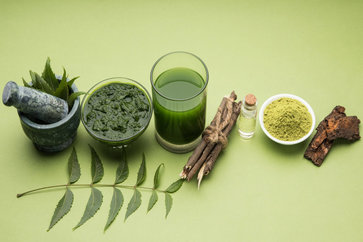Ayurvedic Medicine For Fungal Infection (Candidiasis-Thrush) On Skin
Fungal infections are very common, although not so serious in them but can sometimes cause a lot of discomfort and misery. Fungi are a group of micro-organisms that are separated from plants and animals. 
It has several or similar characteristics to the plant. It can grow and spread locally and then spread through spores. The fungi are found in abundance throughout the world but are barely noticeable because of their small size and inconspicuous lifestyle.
It is noticeable unless it causes an undesired effect such as a skin rash. When the Fungi take the form of mycelium which is a mass of connected hyphae, it then grows with the absorption of water and nutrients like roots of a plant.
These organisms when growing on the surface of the skin or mucous membrane in humans it causes irritation on the underlying surface and established unpleasant condition such as burning or itching sensations.
The plaques of fungi that are formed on the skin can be difficult to eradicate because they reproduce by spores, like a tiny seed. They are so minute that they are unable to see with the naked eye, they are even resistant to some chemical detergents and heat.
They can survive for long periods of time on the skin and then become active when conditions are appropriate. Below are some of the common fungal infections and their causes
Common Fungal Infections
Ringworm: It is a type of fungal infection that is highly infectious. This type of infection generally appears to be around a ring-like shape.
It is commonly found on all surfaces of the skin. It can also infect nails as tinea. The Ringworm fungal infection starts slowly but if untreated it can infect the entire body surface and may end with very itchy and uncomfortable.
Note: It can cause infection from person to person.
Athlete’s Foot / Feet: This type of fungal infection mainly gets infects between the toes, it sometimes can also be found on the sides of the feet or in and around the toenails.
Jock itch: This type of fungal infection mainly gets under the thighs and groin area.
Causes Of Common Fungal Infections
Ringworm: It is also known as tinea, it is generally passed from one infected animal or by physical contact to another person. This fungus is highly contagious so good personal hygiene is necessary. One should avoid contact of an infected person or certain animals which are infected, is very important.
Athlete’s foot: This type of fungal infection is generally caused by using dirty socks or sharing them with an infected person. It can also be caused by using public showers or pools. It is also found in the person whose feet are wet more time due to water or the person have very sweaty wet feet.
Jock Itch: This type of fungal infection is found in a person who has poor personal hygiene. If not look forward it can trigger candidiasis. The use of unclean underwear or having a very sweaty groin area could also contribute to this problem.
Besides this common fungal infection, there are also fungal infections known as yeast or Candida, it is no fun at all especially for women. An overgrowth of Candida causes a lot of seemingly unrelated ailments.
It sometimes can also be confusing to the doctor and the patient. It is because the people who suffer are not aware that they have overgrowth Candida until they become seriously ill.
What is Candidiasis?
Candida albicans is a fungal organism that generally develops in the mouth, skin, and gastrointestinal tract. We generally have healthy bacteria yeast (a type of fungus) in our bodies. A yeast infection results due to overgrowth of a type of yeast called Candida or Candida albicans.
There are more than 20 species of Candida, Candida albicans are the most common among them. It generally caused or becomes active when our immune system is compromised by stress or the use of antibiotics or we are sick.
Yeast infections are commonly found among people who tend to be with moist or with wet conditions, such as whose hands are often in water.
people whose clothing retains body moisture or the children who suck their fingers. Diaper rash is also termed as dermatitis is due to Candida yeast growth in the folds of the skin of a baby.
Different Types Of Candidiasis
Oral Candidiasis: This type of fungal infection can affect affects young children, infants, and the elder. It is a painless infection found in the area of the mouth and throat with often recurring in nature.
Oral Moniliasis: This type of infection is also known as thrush. It is painful in nature, it is generally seen as a vaginal yeast infection and most women have experienced it. It is commonly found during pregnancy or during treatment with antibiotics.
Balanitis: Balanitis is a yeast infection of the penis, it can occur at any age. It mostly affects the boys under four years of age but some adult males also get in some circumstances. It is a pain in nature and is found generally on the glans (the rounded head) of the penis.
Systemic Yeast Infection: It is a very different type of yeast infection with life-threatening. It is due to the varieties of different fungi that we possibly get from the environment or food and even in the condition of overgrowth of Candida. It has been studied that this type of fungi releases over 100 known mycotoxins (poisons) into the body.
It can affect different parts of the body in different ways such as a person may get adult acne, arthritis, heart disease and can cause all types of such illnesses.
Ayurvedic view
Ayurvedic medicine is a traditional system of medicine that originated in India. That has been practiced for over a thousand years. The Ayurveda medical system uses a combination of mind, body, and spiritual medicine for better health and wellness. The treatments are base on various dietary changes, herbal medicine, and spiritual to bring the body back into balance.
Ayurveda does not identify Candida as a single main reason or the causative agent that causes the disease. In Ayurveda Candida albicans is defined as a parasite disease and known as “krumi”.
It is therefore treated as a parasitic infection that is caused by AMA (toxins) in the body. In Ayurveda Candida is classified as a symptom of overgrowth Candida under the title “Agnimandaya” Which means “poor digestion”.
The overgrowth Candida is due to poor digestion and assimilation. The production of the AMA (toxins) increases, which then is circulated to the overall body and in the undigested food.
It is believed that AMA is either absorbed by the bloodstream or lymphatic system that ultimately creates a toxic environment in the overall body.
Ayurvedic Treatment For Candida
In Ayurveda, it is believed that the etiology or underlying cause of the uncontrolled Candida is due to “agnimandaya” (poor digestion). It results in the production of AMA, which then accumulates in the seat of Vata in the lower digestive tract.
The accumulation of AMA in the small and large intestines gets rot and ferment, thus inhibiting the normal flora of proliferation. Under these circumstances, the yeast has a free hand to spread through the intestines unchecked. As a result, the seven tissues are damaged which include
- Rasa (plasma)
- Rakta (blood)
- Mamsa (muscle)
- Medha (fat)
- Majja (nervous tissue)
- Asthi (bone)
- Sukra (sperm and ovum)
These damaged tissues function poorly, resulting in a lack of luster and vitality. The dhatus are designed to perform succession, and if any of the dhatus are improperly formed the Sukra production is inhibited. The Sukra is the final completion of the digestive process, the dhatu development that provides vitality, immunity, procreation, health, and long life
So to take the ride of Candida properly diet with medication is needed.
Vata Type Candida
The Vata dosha is aggravated by excess intake of spicy, bitter, and astringent food. Food like sugar, nuts, and dairy products are difficult to digest which then produces AMA. Consuming too cold food and excessive travel can suppress natural and normal impulses.
Excessive intercourse, irregular eating, and sleep habits can result in this ailment. The Signs of Vata aggravation include dryness of skin, mood swings, nervousness, and inability to cope.
The other symptoms as gas, constipation, bloating and up-downs in energy levels, sleep patterns are unbalanced. If these signals are combined with yeast imbalance, this may be considered a presentation vata Candida.
Recommended Diet
- The person should consume a diet that decreases AMA. This means avoiding dairy products, sugar, bread, and food that cause mucus production.
- The person should avoid drinking Cold and raw foods. Drink hot water every 20 minutes. Consume eight to ten glasses of hot water mixed with lemon per day.
- Eat a large relaxing meal and a hot soup for dinner. The person must avoid fruit juice, eating fresh fruits in moderation is acceptable.
- Use herbs such as Basil, Hing, ginger, Garlic, and Ajwain to spice up your food.
- Consume probiotics (yogurt/dahi) supplementation in small amounts and fresh-made dairy products or coconut milk yogurt is acceptable.
Pitta Type Candida
Pitta dosha if aggravated can put out the digestive fire; it is the same when a flood of boiling water pours to put out a flame. If a person consumes more fatty, sugar, and spicy foods the Pitta is aggravated.
In Pitta type, Candida infections are also most likely to manifest in the liver and blood. The Signs of pitta imbalance are acidic indigestion with occasional heartburn, sallow, irritability, abdominal distension, and swelling.
The other symptoms such as joint pain, yellowing complexion, loose stools, body temperature, and excessive thirst can be seen. If there is a regular upward flow of Vayu (gas) the Candida problem can be based on mixed Vata with a presentation of pita.
This set of symptoms indicates a cause that requires combined of Vata pitta so support protocol should be monitored both with Vata and pitta.
Recommended Diet
- Eat fresh vegetables raw leafy greens, avoid fruit juice and sugar. Consume fruits, vegetables, spices, herbs that are bitter in taste.
- Consume natural antibiotics such as coconut oil; begin it with a small amount and that gradually increase (dose: 1/2 teaspoon up to two tablespoons).
- Consume Neem oil, it can work as Detoxification which cleanses liver and blood.
Kapha Type Candida
The Kapha dosha is aggravated by excess food intake or heavy foods which are not easy to digest such as oily food, sugar, bread, pasta, and cold. Overeating and sleep quickly after meals produce AMA, it is due to the digestive fire which is enabled to digest food properly.
Yeast problem of Candida in Kapha may generally occur with low immunity, water retention, swollen glands and heavy state of mind, fatigue, excessive sleep with symptoms of nausea and vomiting.
Recommended Diet
- Include herbs and spices which are hot in nature like black pepper, curry, pepper, ginger, and cloves.
- Avoid all mucus-forming food; consume bitter flavor food and astringent leafy greens to reduce excess mucus.
- Avoid eating fat, greasy foods, sugar, and salt. Eat food like cereals; vegetables, spinach, Dandelion, cabbage, asparagus, kale, etc.
Note: You should apply all-natural remedies to a certain stage, but beyond that, you should consult a doctor to cure the problems before it gets worsened.
In today’s active lifestyle, anyone can get a fungal infection and it is quite common. There are many herbal remedies that can destroy the fungi which cause infection and reduce the intensity of symptoms.



























One of the important ayurvedic treatment. Thanks for sharing with us
It is estimated that three in four people worldwide suffer from a yeast infection and sufferers continue to grow more, This means that conventional drugs are getting less and less effective causing patients to have another look at natural cures for yeast infections.